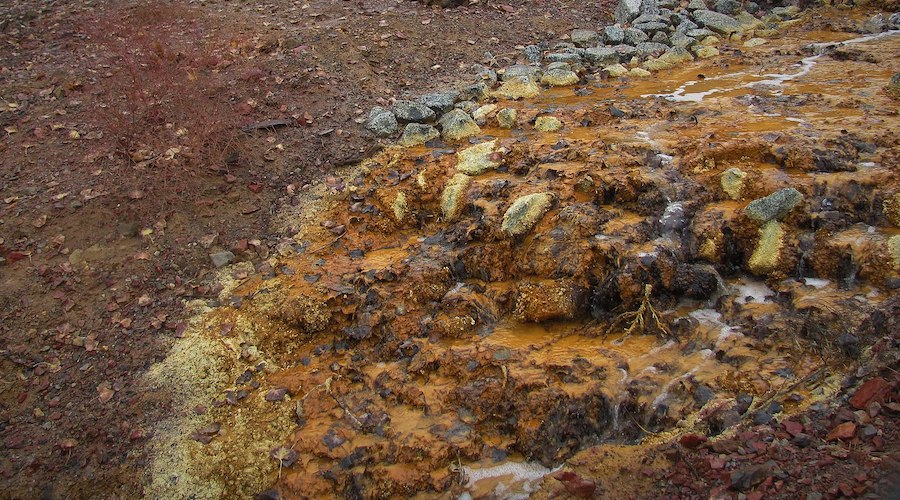Staff Writer | November 22, 2022 |

Mercury-polluted water at the New Idria mercury mine in the US.
(Reference image by Joe.nehls, Wikimedia Commons.)
Researchers at Zhejiang University and the University of Maryland have discovered that the fungus Metarhizium robertsii removes mercury from the soil around plant roots, and from fresh and saltwater.

In a paper published in the journal Proceedings of the National Academy of Sciences, the scientists point out that their findings could provide an inexpensive and efficient way to protect crops grown in polluted areas and remediate mercury-laden waterways, such as those close to gold mining operations.
In detail, the study shows how Metarhizium stops plants from taking up mercury. “Despite being planted in polluted soil, the plant grows normally and is edible. What’s more, the fungus alone can quickly clear mercury from both fresh and saltwater,” UMD professor of entomology and co-author of the study, Raymond St. Leger, said in a media statement.
St. Leger explained that Metarhizium is a nearly ubiquitous fungus that colonizes plant roots and protects them from herbivorous insects.
Scientists have known that Metarhizium is often one of the only living things found in soils from toxic sites like mercury or artisanal gold mines. But no one had previously determined how the fungus survived in mercury-polluted soils, or if that had implications for the plants the fungus normally lives with.
Researchers at Zhejiang University and the University of Maryland have discovered that the fungus Metarhizium robertsii removes mercury from the soil around plant roots, and from fresh and saltwater.

In a paper published in the journal Proceedings of the National Academy of Sciences, the scientists point out that their findings could provide an inexpensive and efficient way to protect crops grown in polluted areas and remediate mercury-laden waterways, such as those close to gold mining operations.
In detail, the study shows how Metarhizium stops plants from taking up mercury. “Despite being planted in polluted soil, the plant grows normally and is edible. What’s more, the fungus alone can quickly clear mercury from both fresh and saltwater,” UMD professor of entomology and co-author of the study, Raymond St. Leger, said in a media statement.
St. Leger explained that Metarhizium is a nearly ubiquitous fungus that colonizes plant roots and protects them from herbivorous insects.
Scientists have known that Metarhizium is often one of the only living things found in soils from toxic sites like mercury or artisanal gold mines. But no one had previously determined how the fungus survived in mercury-polluted soils, or if that had implications for the plants the fungus normally lives with.
A copycat
St. Leger and other colleagues had previously sequenced the genome of Metarhizium, and Weiguo Fang, lead author of the paper, noticed that it contains two genes that are very similar to genes present in a bacterium known to detoxify, or bioremediate, mercury.
For the current study, the researchers ran a variety of laboratory experiments and found that corn infected with Metarhizium grew just as well whether it was planted in clean soil or mercury-laden soil. Moreover, no mercury was found in the plant tissues of corn grown in polluted soil.
The researchers then genetically modified the fungi, removing the two genes that were similar to those in mercury-remediating bacteria. When they replicated their experiments, modified Metarhizium no longer protected corn plants from mercury-laden soil, and the corn died.
To verify that the genes were providing the detoxifying qualities, the researchers inserted them into another fungus that does not normally protect corn from mercury. The newly modified fungus performed like the Metarhizium, protecting the plants from mercury-laden soil.
Microbiological analyses revealed that the genes in question expressed enzymes that break down highly toxic organic forms of mercury into less toxic, inorganic mercury molecules.
Genetically engineered
Lastly, the researchers genetically engineered Metarhizium to express more of the detoxifying genes and increase its production of the detoxifying enzymes.
In their final experiment, the scientists found they could clear mercury from both fresh and saltwater in 48 hours by mixing in Metarhizium.
According to St. Leger, the next step will be to conduct experiments in the field in China to see if the fungus can turn toxic environments into productive fields for growing corn and other crops.
“Allowing plants to grow in mercury-rich environments is one of the ways this fungus protects its plant home,” St. Leger said. “It’s the only microbe we know of with the potential to be used like this because the bacteria with the same genetic capabilities to detoxify mercury don’t grow on plants. But you can imagine simply dipping seeds in Metarhizium, and planting crops that are now protected from mercury-rich soils.”
In addition to its potential as a cost-effective tool for reclaiming polluted lands for agriculture, the fungus may help clear mercury from wetlands and polluted waterways that are increasingly threatened by mercury pollution as climate change and melting permafrost accelerate the release of the toxic metal into soils and oceans.
No comments:
Post a Comment